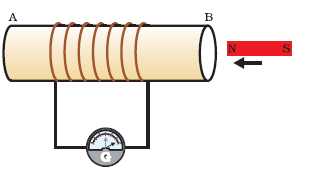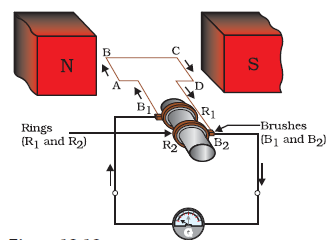Electricity
The fact that amber rubbed with wool or silk cloth attracts light objects has been known since ancient times throughout the world. We have seen lightning strikes, but both of them are connected was never known until modern times. In this chapter, we will establish the basics of the Electricity.
Electric charges
- Electric charges
- Electroscope
- Charges by Induction
- Conductor and Insulator
- Electric Potential
- Ohm’s Law
- Resistivity
- Heating Effect of Electric Current
- Power
- Application of Current’s heating
- Magnetic Effects of Current
- Magnetic field due to current carrying conductor
- Right-Hand Thumb Rule for Circular Loop
- Current in Solenoid
- Current Carrying Conductor in Magnetic Field:
- Electric Motor:
- Electromagnetic Induction:
- Electric Generator
Very simple experiments can establish the fact about the existence of two types of charges.
- Glass v/s Wool: It is observed that if two glass rods rubbed with wool or silk cloth are brought close to each other, they repel each other. The two strands of wool or two pieces of silk cloth, with which the rods are rubbed, also repel each other. However, the glass rod and wool attracted each other.
- Conclusion 1: Like charges repel each other.
- The glass must have one type of charge which repels itself.
- Wool must have one type of charge which repels itself.
- Conclusion 2: There are two types of charges and Unlike charges attract each other.
- If Glass and wool had the same type of charges, they would have repelled each other, but this is not the case. Thus the charges are different and they attract each other.
With more experiments conducted, we can find only two types of charges.
We, very conveniently call them Positive and Negative charges.
Electroscope
A simple apparatus to detect charge on a body is the gold-leaf electroscope. It consists of a vertical metal rod housed in a box, with two thin gold leaves attached to its bottom end.
When a charged object touches the metal knob at the top of the rod, charge flows onto the leaves and they diverge. The degree of divergence is an indicator of the amount of charge.
However, it cannot tell which type of charge is it, Positive or negative.
Charges by Induction
- Capacitor
Conductor and Insulator
Properties of Charges
- Charges are conserved.
- Charges are quantised: We can verify this with the millikan’s Oil Drop experiment.
- e = 1.602192 × 10 – 19 C
- Thus, there are about 6 × 1018 electrons in a charge of –1C.
Force Due to a charge
The force of attraction or repulsion between two charged objects kept at ‘r’ distance apart is given by the following formula:
Where εo = 8.854 × 10-12 C2 N–1 m–2
Electric Field
Every charge creates a field around it, in which every other charge would experience a force. We call this an electric field. The electric field of a body is the force experienced by a unit charge around it.
Electric Potential
Electric Current
If the electric charge flows through a conductor (for example, through a metallic wire), we say that there is an electric current in the conductor.
Current flows by virtue of a potential difference.
- V α I
Ohm’s Law
- V=IR
Resistivity
Resistivity is a fundamental property of a material that quantifies how strongly it resists the flow of electric current. It is an intrinsic property, meaning it depends only on the material itself and not on its shape or size. The resistivity of a material is denoted by the symbol ρ (rho).
The resistance (R) of a material can be calculated using the formula:
R = ρ . lA
Where:
- R is the resistance,
- ρ is the resistivity of the material,
- L is the length of the conductor,
- A is the cross-sectional area of the conductor.
The SI unit of resistivity is ohm-meter (Ω·m).
The Resistivity itself depends on the material type and temperature.
- The higher the temperature, the higher the resistivity shown by the material.
Circuit diagram, Resistance of the system of resistors (Series, Parallel)
The SI unit of Potential difference is Volts. Here, 1V = 1J/1C. Therefore, potential difference is also known as Voltage.
Heating Effect of Electric Current
H = VIt (Energy)
Power
The rate of energy flow is known as power.
- P = V Q/t = VI (Energy/time)
- Electric power: P = VI = I2R = V2/R: Rate of consumption of Energy.
- 1W = 1 VA
- 1kWh – 1000W X 3600s = 3.6X106 J.
Application of Current’s heating
- Bulbs: Electric bulbs use Tungsten filament (with a melting point of 3380oC). These are thermally isolated as much as possible and therefore are filled with chemically inactive Nitrogen and Argon to prolong the life of the filament. (Insulate & inert). However, most power utilised by bulbs mostly creates heat, and only some portion of power creates light.
- Fuse: A fuse is a safety wire that melts at high temperatures. When too much energy passes this wire, it heats up and melts, breaking the circuit. Thus, a short circuit prevents any hazard such as damaging appliances or electrocution.
Magnetic Effects of Current
Magnetic field:
A vector, Direction taken as the direction of the North pole (taken by convention that field lines emerge from North to South)
- A magnetic field is a region around a magnetic material or moving electric charge where magnetic forces are exerted. It is represented by magnetic field lines that show the direction and strength of the field. Magnetic fields are responsible for the operation of devices like motors, transformers, and compasses.
- They are closed curves.
- Field lines: Show the magnetic field and strength is shown by closeness.
| Hans Christian Oersted (1777-1851) |
| Oersted played a crucial role in understanding electromagnetism. He accidentally discovered that a compass needle got deflected when an electric current passed through a metallic wire placed nearby. This showed that Electricity and magnetism are related phenomena.
His research later created a lot of technologies: Radio, television, fibre optics. In order to honour his Legacy, the Unit of Magnetic field is called Oersted. |
Magnetic field due to current carrying conductor
- For a straight wire: Right-hand thumb rule.
- For Circular loop: Can apply the right-hand thumb rule in two ways.
- Current in Solenoid.
- Current-carrying conductor in Magnetic field: French scientist Andre Marie Ampere (1775–1836) suggested that the magnet must also exert an equal and opposite force on the current-carrying conductor.
- Fleming’s left-hand rule(Magnetic Force): Thrust field current. Thumb first second.
Right-Hand Thumb Rule for Circular Loop
The Right-Hand Thumb Rule can be applied in two ways for a circular loop of current:
- Direction of Magnetic Field: If you curl your fingers around the loop with your right hand, your thumb will point in the direction of the magnetic field at the center of the loop. This indicates the orientation of the magnetic field lines produced by the current.
- Direction of Current: If you hold your right hand with the thumb pointing in the direction of the current in a circular loop, your fingers will curl in the direction of the magnetic field lines.
Current in Solenoid
A solenoid is a coil of wire with current passing through it. When current flows through the solenoid, it creates a uniform magnetic field inside it.
The magnetic field lines inside are parallel and evenly spaced, indicating a strong magnetic field. The solenoid behaves like a bar magnet, with distinct north and south poles. The direction of the magnetic field can be determined using the right-hand thumb rule: when you curl your fingers around the solenoid in the direction of the current, your thumb will point in the direction of the magnetic field inside the solenoid.
Current Carrying Conductor in Magnetic Field:
When a current-carrying conductor is placed in a magnetic field, it experiences a force. The direction and magnitude of this force depend on the current, the magnetic field, and the length of the conductor.
Fleming’s Left-Hand Rule (Magnetic Force):
Fleming’s Left-Hand Rule is used to determine the direction of the force experienced by a current-carrying conductor in a magnetic field. It is based on the interaction between the magnetic field and the current:
- Thumb: Points in the direction of the force (motion of the conductor).
- First Finger: Points in the direction of the magnetic field (from north to south).
- Second Finger: Points in the direction of the current (from positive to negative).
Using this rule, the force acting on the conductor can be predicted, which is a crucial principle in electric motors and generators.
Electric Motor:
Electromagnetic Induction:
Fleming’s Right-hand Rule (Induction): 
- Thumb: Thrust (motion),
- First Finger: Field.
- Current induced: second finger.
| Michael Faraday |
| Michael Faraday was an experimental physicist who had no formal education. He worked in a bookbinding shop, where he developed an interest in science. He had the opportunity to attend public lectures by Humphry Davy at the Royal Institution. Faraday carefully took notes on Davy’s lectures and sent them to him, which eventually led to Davy appointing him as a laboratory assistant.
Faraday went on to make groundbreaking discoveries in electromagnetic induction and the laws of electrolysis through his independent research at the Royal Institution. Despite receiving honorary degrees from several universities, he turned them down. |
Electric Generator
MRI: Magnetic Resonance Imaging: Nerve cells carry a very small amount of current that produces a temporary magnetic field. It is very small; the only organs that produce significant magnetic fields are the Heart & Brain; This is detected by MRI which is analysed for diagnosis.
Ammeter: Current; Voltmeter, Potentiometer: Voltage;
Galvanometer: Direction of current.
Electricity is the flow of electric charge, usually carried by electrons in a conductor like a metal wire.
Ohm’s Law states that the current flowing through a conductor is directly proportional to the voltage applied, provided temperature remains constant. (V = IR)
Electricity is crucial for understanding renewable energy, power generation, smart grids, electric vehicles, and rural electrification in India — all UPSC-relevant topics.
The SI unit of electric current is Ampere (A).
Electricity powers homes, industries, transport, communication systems, healthcare equipment, and is key to India’s energy policy, Smart Cities, and Digital India initiatives.








